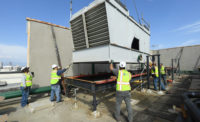After years in the doldrums, many specialty contractors have seen improved market conditions this year and are spotting signs of an even better market in 2015. The increased activity that design firms and general contractors have been reporting is filtering into the field, allowing subcontractors to be more selective and strategic when bidding.
Nick Thrappas, president of the American Subcontractors Association of Baltimore and president of ARC Construction, says he sees much more optimism among members of his ASA chapter. "The market has improved quite a bit, and the work opportunities are increasing," he says, noting that he has seen particular improvement in corporate office work.
Ike Casey, ASA Metro Washington president, says recent bid activity suggests that specialty contractors could see a significant uptick in work next year. "There's a lot of work in bidding right now. As soon as that work breaks, we could be looking at [subcontractors] talking about labor shortages again," he adds. Casey says he sees many chapter members currently banking on multifamily residential work, but he expects other sectors to improve next year.
Some specialty contractors in the region have emerged from the recession in a stronger position than before. EMCOR—which has many affiliates in the region, primarily in the electrical and mechanical fields—reported 2013 mid-Atlantic revenue of $976.6 million. That's up from $465.8 million in 2008. All of that growth has been in EMCOR's mechanical business, which rose to $802.7 million last year, from $272.5 million in 2008.
MasTec also appears well-positioned to take advantage of market opportunities. The company, which posted $419 million in regional revenue in 2013, reported record revenue of $4.3 billion across the entire company last year. Within that national tally, revenue from the oil and gas sector jumped 70% compared with 2012. While oil and gas is a burgeoning sector in the region, MasTec also has seen steady growth in other market segments, including communications infrastructure and power generation. In May, MasTec acquired telecom and IT company Speedwire.
In western Pennsylvania, contractors already see a significant pickup in oil-and-gas-related opportunities, says Jeff Burd, president and owner of Tall Timber Group, which provides forecasts for ASA of Western Pennsylvania. Burd sees trades opportunities beyond traditional vertical building projects. "A lot of the construction trades, like pipefitters and welders, apply as well to natural gas," he says.
Burd says the big project that many trades are eyeing is a $4-billion ethane cracker near Pittsburgh proposed by Shell Chemicals. "If that goes—and I think it will—that will set off a whole chain of events that ramps up activity," he says.
Burd also notes that he sees more highway work in Pennsylvania coming for contractors, thanks to the 2013 passage of the state's $2.3-billion transportation bill. "That work is just picking up now," he says.
Given that potential new work, Burd says he expects labor capacity will be a growing concern next year. "Around 80% of construction dollars are with union contractors, and many union [locals] are near full employment," he says. "On top of that, they are dealing with a wave of retirements. We have a real workforce issue on our hands that could impact productivity."
Despite the infrastructure and industrial opportunities, Burd says the volume of vertical construction, particularly commercial, remains lower than expected. Based on low vacancy rates and other factors, Burd had forecast that the Pittsburgh area would see about $3 billion in construction starts this year. Now he anticipates activity could be closer to $2.5 billion.
"I've never seen a place where the metrics were this favorable and the area is not in a construction boom," he says. "It all comes down to a lack of confidence and a lack of money to push these projects forward."







